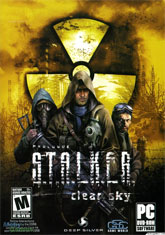 Review by Steerpike
Review by Steerpike
S.T.A.L.K.E.R.: Clear Sky
Developer GSC Game World
Publisher Deep Silver, Steam
Released September 21, 2008
Available for Windows
Verdict: ![]() 3/5 Middlin’
3/5 Middlin’
“In the end, Shadow of Chernobyl stood above its many, many flaws because it was a revolutionary title, a game-changer. Clear Sky, though in many ways a far superior game, does not enjoy the same immunity to its flaws, because it’s supposed to be of the second generation, and the mistakes you see in it stink of the first.”
The Evil Empire
When Max Payne slipped into its second year of delay with no end in sight, the developers at Remedy Entertainment had t-shirts printed:
they said, so whenever developers glanced down at themselves they were reminded of their mission. Eventually Max Payne did ship, to great acclaim.
In the case of GSC Game World’s S.T.A.L.K.E.R.: Shadow of Chernobyl, publisher THQ took a more direct approach, dispatching an enforcer to GSC’s Ukrainian headquarters, a man whose job was to take a team that had long since lost its way and beat them until a game came out. Once on the fast track, brutal cuts were made. Whole sections of the game were stripped away at his order. Eventually STALKER did ship, to great acclaim.
STALKER was in many ways a badly broken game, and certainly didn’t realize the enormity of its potential, but it was revolutionary and unforgettable. Its success allowed GSC the luxury of promising “several” additional games in the STALKER universe, one inspired by the novel Roadside Picnic and Andrei Tarkovsky’s film Stalker. The STALKER universe is also inspired by Chernobyl, a neighborhood GSC lives not far from, and it was the depiction of the forbidden Exclusion Zone, the poisoned territory surrounding the shattered remains of Reactor Four, that truly sealed the game’s position as a towering masterpiece of atmosphere.
But THQ washed its hands of GSC Game World – loudly and publicly – bringing its corporacutioner home and leaving the studio adrift to find a new publisher. This was surprising, certainly, because despite the game’s great cost and many setbacks, it wound up performing very well. The cult of STALKER, of which I am a card-carrying member, all but ensured strong sales of a sequel.
So GSC went on to announce S.T.A.L.K.E.R.: Clear Sky, a prequel to the events in Shadow of Chernobyl. The studio cast about for a publisher, and finally found one in Deep Silver.
The lesson here is that while gamers might revile publishers for bullying studios and ruining great product more often than salvaging mediocre, sometimes a strong hand is needed. It’s hard to say who did what when and with whom, but GSC’s fecklessness threatened their masterpiece, and it looks like THQ actually saved the day. Deep Silver, apparently lacking the strength of will to stand up to the studio, allowed GSC Game World to ship a title that – while good – isn’t nearly as good as it could or should be.
In the end, Shadow of Chernobyl stood above its many, many flaws because it was a revolutionary title, a game-changer. Clear Sky, though in many ways a far superior game, does not enjoy the same immunity to its flaws, because it’s supposed to be of the second generation, and the mistakes you see in it stink of the first.
To put it another way, if their release were reversed and Clear Sky shipped in 2007, it’d have been hailed just as much as Shadow was. But in the end, for all their efforts, GSC simply wasn’t able to deliver a second revelatory experience, and one must wonder how much if this is due to the studio’s apparent inability to master its own ambition. Where THQ forced often painful decisions in the interest of making a better game, Deep Silver apparently did not. And as such this game suffers.
Kill the Strelok
Clear Sky is set a year before the events in Shadow – a game that saw the mysterious amnesiac Stalker nicknamed “Marked One” penetrate deeper into the Zone than anyone else on quest to murder… himself. The Stalker named Strelok is the protagonist of Shadow but the villain of Clear Sky, a man obsessed with reaching the center of the Zone, that toxic realm whose beating heart is the ruins of the Chernobyl Nuclear Power Plant. Strelok and his gang believe that the fabled Wish Granter, an artifact that supposedly does exactly what its name suggests, lies inside the reactor, and they are determined to reach it and the riches it promises.
But the Zone itself, much more a living character in this installment, denies them vigorously. As those who finished Shadow carelessly discovered to their sorrow, Strelok is wrong. The dark purpose of the Wish Granter is not what they think; indeed, its circular role is not to bequeath but to eliminate – the Wish Granter exists to destroy anyone who would use the Wish Granter. It’s a self-correcting mechanism over the power of the Zone, implied but never explicitly stated in either the movie or the book.
Clear Sky opens with a troupe of scientists hiring a Stalker nicknamed Scar to lead them to the Reactor. As they approach, a massive blowout shakes the Zone: an immense radiation storm from the now-sentient power plant that darkens the sun and bruises the sky, drives animals before it, kills all who cannot find shelter. None but Scar survive. He is found by members of the mysterious Clear Sky organization, ostensibly a scientific team, but alarmingly well-armed for mere research. Strelok’s invasion of the Zone’s heart has caused an instability in the region. Like an immune system responding to a virus, the Zone is defending itself, and Clear Sky believes that only by eliminating Strelok can the balance be restored. As Scar, that’s your job.
Lord of the Flies
They did so many things right in Clear Sky.
Those who played Shadow of Chernobyl recall the infuriating frequency of weapon failures and armor degradation, the dull monotony of side quests in what’s supposedly an open-world extravaganza, the supposedly priceless anomaly-thrown artifacts lying around by the hundreds, and of course the annoying and childish faction wars that served largely as an impedance to progress.
All of that is gone or improved, and some of the changes fall into the “godsend” category. Not only can armor and weapons be repaired, but enormous upgrade trees encourage Stalkers to specialize in their weapons and equipment of choice, seeking out flash drives containing vital information that will allow mechanics and engineers to further pimp out your gear. Side quests are complicated and varied, all but demanding that you spend hours lingering in the rich open-world portion of the game that comprises the first two thirds of play. Deadly anomalies are practically invisible and artifacts are invisible, requiring the purchase of expensive detectors and the exercise of great care to seek these treasures out. When you do find them, they are often of shockingly high monetary value, but so dangerous that equipping one on your own person is an exercise in self-destruction. You finally get the sense of why Stalkers would risk so much to come to this violated place, where death is ever present and every moment filled with danger. And while the major factions are still clichéd and irritating, at least their conflict feels part of the game, rather than some tacked-on immensity that adds no value.
That first two thirds, the open world section, are best dawdled in and enjoyed. This is your opportunity to really experience the adventure of this fictional Chernobyl, to see why these people would be willing to be there, living that life. Moreover, you see the pointlessness of existence in the Zone, as the faction wars drag on and the corpses pile up. More than once you’ll find yourself defending or attacking some useless, meaningless chunk of irradiated land, watching friends fall and bullets fly as Stalkers fight and kill like little boys (again, no women in the game, sorry) to hold or take useless heaps of ruined junk and ramshackle buildings. Nothing here matters, everything is poisoned; it’s all worthless. But these sad little men simply can’t stop killing each other over it. One time I was tasked with holding a strategic point until reinforcements arrived. It was a pile of empty crates next to a rusted-out car. It had no purpose. Another time I and fellows carried out a daring pre-dawn raid on an immense abandoned factory complex that contained nothing of value. Dozens died on both sides… why? So my side could control an immense abandoned factory complex that contained nothing of value. There is a heartlessness in this game that rings far truer than it did in Shadow, and experiencing it as such is both painful and revelatory.
They did so many things wrong in Clear Sky.
Enemies attack by the scores, not as big a crime as you might think, since the point of this game is that this is the Zone that was, when it was crowded and desperate, not the corpse-littered, lonely world you experienced in Shadow. But the A-Life artificial intelligence system that commanded a second-to-none tactical combat AI in Shadow has been gutted and ruined, replaced by hordes of marksmen who see you from miles away, through cover and darkness, who shoot you in the face before you even realize they’re looking, who hurl grenades with the accuracy of a major league pitcher. The game is absurdly difficult, even on easy settings, and all but requires a user mod to improve weapon accuracy in order to be playable at all. It is a game of constant quicksaves and reloads, with little bursts of progress between.
There are points in Clear Sky that were meant to be part of Shadow but never made it; things like blowouts (they’re inexplicably called “Emissions” in this game, which sounds less scary and more… perverted, so I’m calling them blowouts as they used to be called), those colossal radiation storms emanating from the core of the Zone. Blowouts were supposed to be terrifying, to reset anomalies and move radiation patches around. When one threatened, we should have seen Stalkers and animals running, dropping everything in a frantic race for cover, forgetting enmities and faction alliances, united as living things as the alien malice of the Zone turned against them. Instead, you get a blowout warning and all the Stalkers vanish. You run to shelter – of which only a handful of places in each region qualify, and these often haunted by bandits or other foes – then you wait for three or four minutes. Eventually the sky turns red and things rumble and birds fall down and you carry on with your business. Pathetic.
Similarly, small fixes desperately needed have been ignored. While inventory management is improved, you lose stamina too fast when running and do not regain it while walking, meaning if you wish to get somewhere fast you must sprint, stop, sprint, and stop again in an annoying hopscotch toward your destination. There’s no way to sleep at night or otherwise pass time quickly. Weapons are ridiculously inaccurate (in your hands, that is, not in the hands of the Olympic sharpshooters who populate the Zone’s AI), and despite regular repairs they still fail and jam far too often. Load times are inordinately long, and the poorly optimized game engine reduces frame rates to single digits on machines capable of taking on Deep Blue.
Another problem with Clear Sky is that it takes place in the same Zone. Aside from a handful of new locations, you’ll be adventuring in the same places you’ve been to before: the Cordon, the Garbage, Agroprom, Dark Valley; you spend at least 70% of your game in these locations, and while they’ve been retextured to show off new visual effects, they are the same places. The sense of wonderment and exploration that made Shadow so powerful is heavily weakened by this. Sure, factions and anomalies have moved around, but in general there’s a sense of having been here before. And while the few new regions are exciting and beautifully rendered, they’re either too remote to visit often or part of the intentionally linear second chunk of the game, when the nonsensical storyline drives you relentlessly forward to the inevitable confrontation at the power plant, with no room or time for exploration.
That final confrontation, too, needs a special mention. The last two hours of Shadow – the warzone in the abandoned city of Pripyat, followed by the nightmare battle outside the power plant itself – were perhaps the best designed two hours of first person gaming ever created. And while the final moments of Clear Sky retain much of the exhilarating madness that tinged your first visit to the power plant, the overall experience is simply not comparable. In desperation, I finally had to reduce the difficulty to its lowest setting in order to finish the game. After that I was treated to a movie that did literally zero to set up the storyline and in fact raised more questions than it answered, rather than explaining all the loose plot points left dangling by Shadow, as it so easily could have done.
Steerpike’s Big Upgrade
My PC was getting a little old, so I poured some money into a new gaming machine partly created with Clear Sky in mind. We’re talking quad-core processor, four gigs of memory, elephantine video card, the works. In general, Clear Sky performed okay on my new computer, but truth be told it should have flown. Once again it’s proof that GSC’s most serious mistake in the STALKER development cycle was its insistence on building a proprietary engine, which shows new features in this prequel but is still poorly optimized and buggy.
The updated X-Ray Engine offers huge DirectX 10 enhancements, which of course you’ll need the abominable Windows Vista to appreciate. Another review said, and I concur completely, that Clear Sky is the best use of DirectX 10 to date. It’s also solid, absolute proof that DirectX 10 is the most useless, pointless piece of technology in the history of software. This “best” use of DX10 tech features things like sun rays and rain drops that plop realistically onto certain surfaces… generally speaking, effects so minimal and pointless that you have to stop and look to see them, and if you do you’ll get shot. Meanwhile, these effects – particularly the dazzling sunrises – drag your frame rates into the nether regions, rendering the game unplayable during certain times of the virtual day.
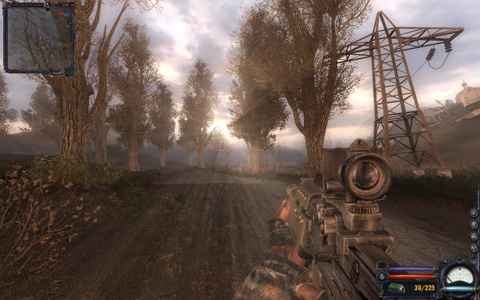
God rays and similar DirectX 10 effects look great, but they'd bring a Cray supercomputer to its knees.
Clear Sky really benefits from video cards with a gigabyte of memory if you intend to run it with the DX10 features on. It performs much more admirably in DirectX 9, but I’m such a sad specimen that I simply couldn’t bring myself to reduce the visuals, despite the fact that the human eye probably can’t tell the difference. Meanwhile, even though the game claims exuberantly to make use of all processor cores on multi-core PCs, by “all” it actually means “one,” a fact borne out by my running Task Manager on a second screen while playing.
GSC has already released several patches for Clear Sky. Those who bought the game over Steam will be patched automatically, but retail purchasers must download them manually, and trust me, you need them. The 1.005 patch – latest as of this writing – hugely improves performance and fixes a whole rainbow of game-breaking bugs, while leaving others untouched.
The Golden Sphere
In general, I feel many of the reviews of Clear Sky have been unnecessarily negative. The game – which is too full of new stuff to qualify as a standalone expansion but too much of a throwback to be a true followup – is in many ways as enjoyable as its predecessor, or more so. But as I said near the beginning, because Shadow really represented a look toward the future of shooter-based gameplay, it was pretty easy to overlook its myriad problems. Clear Sky does the same thing, but what was revolutionary last year is evolutionary today. As such it is judged more harshly, not just because of the things it does wrong, but because of the things that should have been long since corrected and never were.
Clear Sky was released basically as a near-budget title; its $35 retail price, small advertising campaign and low-on-the-totem-pole publisher suggest that the game will not return the numbers its predecessor did. Only the Steam release is likely to turn that around, and with Clear Sky’s review scores hovering in the solidly mediocre realm, even that’s unlikely. As such it’s possible that we won’t see another game in the STALKER universe, though despite this one’s issues I’d happily buy the next. Nothing in Clear Sky is a dealbreaker, iterative improvements have been made, and a return to the bleak and lonely Zone is always welcome.
If there is another STALKER game, GSC must do a number of things – it must decide early on what stays and what goes from a feature perspective; it must get the X-Ray Engine optimized once and for all or switch to a third party engine instead; and it must hire someone with a commanding power over the English language to manage and supervise the localization, not just from a grammar and structure sense, but from the perspective of narrative flow and logic. Indeed, GSC needs someone to write an effective script that makes the storyline as important as the gameplay.
We’re scant days from the release of Ubisoft’s Far Cry 2, a big-budget, big-studio game that takes more than a little inspiration from the open world shooter play mechanics innovated by STALKER. With the might of Ubi’s massive, talented staff and distribution muscle, we may see in Far Cry 2 what STALKER was always supposed to be but couldn’t quite manage.
In the end, I genuinely enjoyed Clear Sky, but I cannot score it above the middle because it’s just not the improvement it should have been. Where Shadow of Chernobyl received a Thumbs Up when I desperately wanted to give it a Gold Star, Clear Sky gets the Middlin’ verdict even though I kind of want to score it higher. My advice to those who enjoyed the original is to give this one a try, but know what you’re getting into: a similarly flawed execution of a brilliant concept, and a game that posterity will likely remember much more kindly than the present.
Minimum System Requirements: Windows 2000 SP4/XP/Vista; 2.0GHz CPU; 512 MB RAM, 128MB video
Reviewer’s System: Windows Vista SP1; Core 2 Quad Q9450; 4GB DDR3 RAM; 512MB Radeon 4870



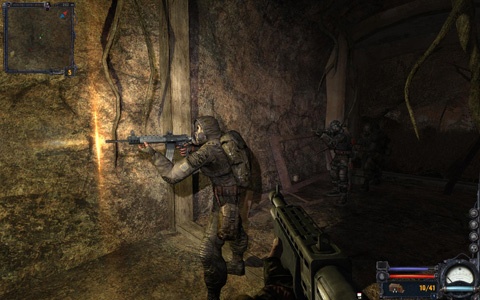
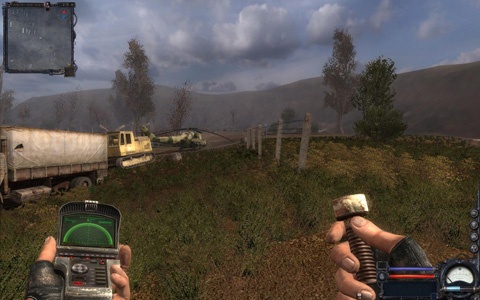

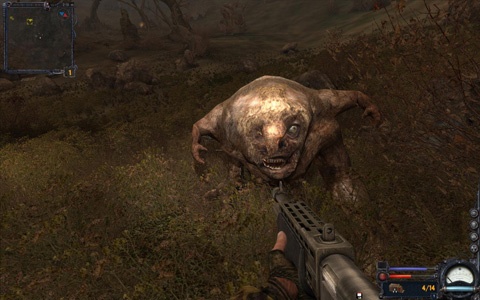
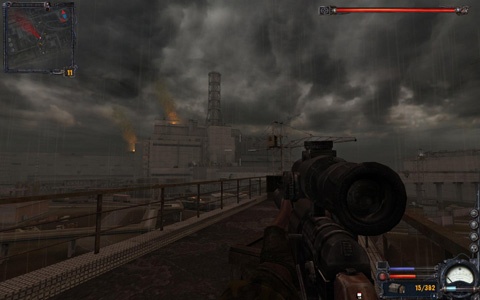
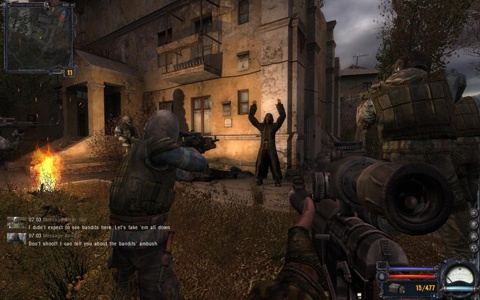
I felt like I was reading a short novel. That is the biggest, and clearly the smartest, most intelligent review I have ever had the pleasure of reading. That said, I must add that based on your review I suspect it doesn’t answer the criticisms of your self-appointed famous novelist brother. Where is the intellect, where are the smarter bad guys? In short, where is the depth?
Although I generally disagree with famous people, I have to admit his comments regarding graphics and graphic excellence certainly seem to keep pace in S.T.A.L.K.E.R.: Clear Sky. Truly beautiful, but playing the game is not unlike playing every other game, kill, kill, kill.
Sorry, Steerpike, but every once in a while, I really begin to miss the old goodies like Mystery House, games that made you think. You write a tremendous review though, Steerpike, keep up the good work, but shorten them a little.
>>>I have to admit his comments regarding graphics and graphic excellence certainly seem to keep pace in S.T.A.L.K.E.R.: Clear Sky. Truly beautiful, but playing the game is not unlike playing every other game, kill, kill, kill.
So says the man who flatly refused to try the profoundly cerebral if dialogue-intensive Planescape Torment, but rubs his hands together with open glee at the thought of another Halo installment. My dad, ladies and gentlemen, he’s here all week.
There is much more to the STALKER games than just kill, kill, kill, though I agree that in this case the intelligence of the enemies is depressing. The STALKER universe is allegorical in the extreme. These are games about a connection to the land, about the humanistic god concept, and most importantly about how the lower beasts might react to a region that has been altered by a sentience so far beyond our own that even its tiniest and most insignificant leavings are both priceless and deadly – much like the leavings of a roadside picnic. Artifacts and anomalies in STALKER are the equivalent of plastic wrap and soda can tabs for mice and ants: unknowable, alien, inherently powerful, and ultimately destructive.
Violence is simply a mechanism in the medium, it rarely makes a statement of its own. Violence is common in games because games are about progress, and violence is a simple way to allude to progress. Just because a game is violent doesn’t mean it lacks literary potential – bear in mind that the STALKER games are inspired by a novel and film considered to be true masterpieces of science fiction.
Mystery House made me think, but only to solve the puzzles. It had small literary merit. STALKER makes me think the way good literature makes me think, and I’ll take it any day over a simple mind-bender.
As to reducing the length, I’ll try, but I really only build up a good head of steam around 2,000 words. Thanks for enjoying the piece. 🙂
As an older gamer, I have to speak in defense of Popquez.
How ironic that you overlook the fact that Mystery House is over 20 years old, it was innovative then and remarkable for its time. At the time, puzzles were the tool that allowed the developer to introduce literary elements to the theme, thus moving beyond the simple killing floor. Doesn’t it disturb you, even a little, that we have moved forward so little in those years. Are we so uncreative that we cannot devise processes by which those “artifacts” as you put it have been “altered by a sentience so far beyond our own that even its tiniest and most insignificant leavings are both priceless and deadly” They are priceless and deadly ONLY if the Player perceives them to be so…and the player can perceive them to be so ONLY if the developer imbues the game with deeper meaning than that of killing beasts. They have to engage the player, daring him or her understand the value of these “leavings.” Furthermore; the player should be left to determine how the “lower beasts might react to a region” that has, could be, will be, or will never be altered by “a sentience far beyond our own comprehension.”
That is the problem with games today, they tell too much; sell too rarely; and, engage the player too rarely leaving little to our creative impulses.
First off, welcome to the site, Gallahad!
Don’t get me wrong, I loved Mystery House. It’s what taught me to read. My earliest memories are of that game. But the truth is there was very little in the way of literary merit there.
As to your remarks concerning Clear Sky, the point I tried to make in the review is that the developer DOES imbue the game with deeper meaning than that of killing beasts. Yes, killing is a large part of the game, but killing is not its point. The point of the game is rooted in humanity’s quest for wealth, for the unknown, and for elements of power beyond that which can be immediately identified. Indeed, both the original STALKER and Clear Sky challenge the player to understand the value of the leavings, and to recognize the amorality of willingness to kill over them – particularly when it becomes clear that these objects, whatever their perceived value, are part of a larger mechanism whose sole purpose is to destroy anyone or anything who would attempt to make use of it.
I agree that many of today’s games don’t engage creative impulses as much as they could or should. But I absolutely dispute the suggestion that games are getting worse in this department rather than better. Look beyond the violence, which is nothing more than a tool to easily denote progression through an interactive space. The ideas are there and often surprisingly rich; developers simply need more practice exposing their themes for consumption.
I recently finished this game and felt much like the reviewer. The best aspects of this game seem to be its compelling atmosphere. Its is dismal and strangely beautiful. It feel like this fertile ground could have been gleaned for even better material. The ending was disappointing, and after beating it on the highest difficulty setting (I always play on that setting but good lord my butt still hurts)the ending was entirely unsatisfactory.
I would like to comment that some of the things that made the first stalker great was how you felt alone, and consumed but the Zone. The “faction system” albeit interesting took away from that.
The review was great, well written and summed up my play experience. Thank you.
The highest difficulty level? Holy cow, Jesse, you have some serious skills and a heck of a lot more patience than I do. That’s a feat for the record books.
The ending, as you say, was meaningless and quite a letdown. I’d have much preferred a more carefully choreographed conclusion that explained some plot points both obscure and banal (like how Clear Sky found your character near the Reactor when they’re based about 50 miles south in the swamps, and how Strelok wound up on the death truck when there’s no way to get to where he winds up).
The loneliness of the first game is also lost in Clear Sky, as you say, and you’re right that there’s much more that can be done with this world. Mostly I hope that GSC returns to the STALKER universe and takes comments such as yours to heart, because I think the STALKER idea still has a lot of strength.
Thanks for your compliments!
I’m going to put up some thoughts on this (and the previous) game on my personal site shortly, but it’s interesting reading this (again, I might add – although I only skimmed so I could enjoy it full on myself).
Interestingly, while the end did rather suck (the last part was infuriatingly hard since it was a sniping gallery level, although the set pieces before were pretty fun), it did actually explain some bits – and the start actually was explained in the starting cut scene – from what you could tell. So, spoilers of course, what happened was:
– Scar was taking the scientists through the *swamps* – the very north exit is exactly the place of the cutscene (scarily so, it has anomalies there, and your busted gun!). Clear Sky, being in the same area, obviously found you pretty quickly I guess though.
– At the end, Strelok was captured by the hive-mind-evil-power-plant-thing, as shown in the cutscene (the branding, who knows where it is from). They didn’t know who he was though (for some reason?) and so it was them who then brainwashed him (removing his own memories) and saying “Go kill Strelok” – and likely with a monolith driver, drove him out into the Corden.
So it fits together, well enough as it is, except Strelok is a bloody cocky bastard and you never meet any of his other team sadly.
However, what annoyed me; Clear Sky obviously has no mention in Shadow, as do the renegades, yet they obviously still have some surviving members – wasn’t the one who tells you about your PDA in Shadow right at the start of the game? and where did the scientist of Clear Sky go? Only the idiot Lebadev was at the power plant…
And what happens to Scar anyway? He’s survived one blowout (and others…kind of, as you said, in empty buildings), so why not another? A shame there, not knowing – you don’t see him in the final short cutscene at all.
A shame there was no exploration or even point to the last levels anyway. A prequel where you know your character must fail is a hard one to really press to the end of. I’d have preferred a different angle although there are moments of clarity through it.
But yes, I agree entirely with the meaty parts of this review, although I see past some of the bad for much, much of the good and with a weight modification I thoroughly enjoyed the game 🙂 I foresee them iterating great improvements, especially in the future, and I’ve been a convert ever since I started Shadow 🙂
Well said, Andrew, and I look forward to the thoughts you promise on your own site. At the end of the day I really loved Clear Sky, especially in light of the failure that was Far Cry 2. Many things were done wrong, to be sure, but if the team at GSC is able to keep iterating the concept, they’ll soon release a truly outstanding product. So far, their Chernobyl games have been both memorable and – at times – utterly brilliant, which isn’t anything to complain about as is.
Damn my lack of upgrading galleries. I’ll get my piece up when I’ve finally sorted screenshots and link back here 🙂
I’ve also got Far Cry 2 (free with my replacement budget graphics card), soooo…well, I’ll have to reserve judgement on that, but I don’t know… I also have basically “finished” Mount & Blade recently, it’s got some tough competition now, heh.
Still will be waiting for the next sequel thing, and number 2, yep, should be good if the iteration works 😀 I can only hope the engine change for number 2 won’t bring the whole mess full circle, heheehehe…
Good review, Clear Sky was really sort of missed opportunity – lots of good elements spoiled by areas pasted from the old game and lots of truly horrible design f-ups. New areas look fantastic on the screenshots until you play and realize they’re linear arenas of unfairly difficult battles (which is real shame, Limansk is beautiful). Fortunately most recent installment of Stalker series is IMO pretty great (already out in my part of Europe).
Apologies for the long delay in approving your comment, ZeeKat, and welcome to the site.
Based in the U.S., I’m cursed to wait until 2/2/10 for Call of Pripyat, but I’m looking forward to the experience!
[…] we’ll see for a while, if not ever. Where Shadow of Chernobyl was moodily terrifying and Clear Sky was atmospherically desperate and crowded, Call of Pripyat is introspective and bleak, a lonely and […]